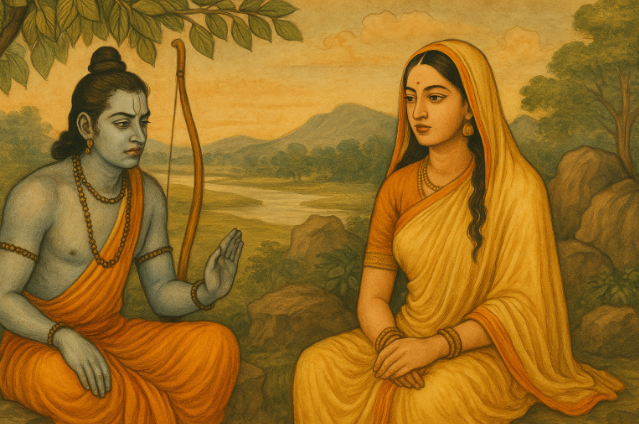
Sita is one of the most important characters in Indian mythology. As the main character of the epic Ramayana, she doesn’t get the attention she deserves in Valmiki’s version, however. The Ramayana tells the story of Rama, the incarnation of Lord Vishnu, and his ordeals in life as a human on earth. Sita is his wife, the spitting image of Goddess Lakshmi herself. Her birth is described differently in each version. Sita’s fire trial and abduction by Ravan forced her to be exiled twice, the second time being when she was pregnant with Luv and Kush. Valmiki’s Sita, still, is a strong Kshatriya woman who speaks up for her rights. Sita’s fire trial is a mythological representation of the mudslinging and curiosity every woman practically has to go through.
The notion of power refers to the idea of being dominant and all-pervasive, despite hurdles along one’s path. On the other hand, submission refers to accepting defeat—a docile nature at its very best. The debate between power and submission came into question with regard to the fairytale narrating the story of Cinderella. But were there not traces of strength in her silent resistance against her cruel stepmother and stepsisters? Strength and power are not always loud; they can be silent yet effective. Similarly, in the case of Sita, her interpreted perspective is a product of the very society we live in. Sita’s strength and power went unnoticed because of the need to represent her as the ideal wife, woman, and mother. For a society obsessed with norms—be it social or gender—the portrayal of a strong female character like Sita is rare. Most of the narratives are male-centric in nature. For an exception, Chandrabati’s Ramayan, Sitayan, and Nabaneeta Dev Sen’s Sita Theke Shuru deal with this inevitable question.
A woman suffering because of an enemy king’s lust—partly fueled by vengeance for his own sister—is nothing new. Sita taking up the form of Goddess Bhadrakali when she faces off against Sahastraravan in the battlefield in the Adbhuta Ramayan shows the true side of Shakti: soft and fierce, both at the same time. Her purity being tested via the fire trial, despite being a pious woman who loved only her husband, deeply reflects social perceptions to this day—a woman is suspected of bad character if she stays out late at night for work. Her ordeal of being exiled to the forest while pregnant with Rama’s children is something single mothers and unwed mothers have been facing forever. Sita was powerful, yet her very human breaking points were described as submission. Getting exiled twice and remaining adamant in the enemy kingdom didn’t deter her from being resistant.
Although there are versions that suggest that the fire trial after returning to Ayodhya was merely to retrieve the real Sita from Agnidev, the god of fire, the idea of a woman being put to scrutiny by those around her is something that cannot be helped. Sita’s rage at her in-laws’ treatment in Chitra Banerjee Divakaruni’s The Forest of Enchantments is something noticeable in many Indian marriages. The way social expectations are thrown at a woman’s face speaks volumes about the perception of women by that same society.
In Chandrabati’s version, too, it becomes exceedingly difficult to live in Ayodhya with a jealous and toxic sister-in-law. Sita’s power shines through her unending resistance to the demon king, Ravan. When the demon king—whom the entire world feared—approached her, asking her to accept her fate as his wife, her courage in denying him and staying adamant, focusing all her heart’s love only on her husband, kept her pure. Sita’s fire trial gave weight to the idea of a woman’s purity. A woman is expected to be pure, regardless of what her husband does. Sita’s character being questioned by a mere dhobi in the Uttara Kanda shows how people criticise women for the misfortunes they are compelled to endure.
Submission to her fate of being rescued by her husband—Sita does finally submit. Her submission may be portrayed as a social norm: that of depending on one’s husband for everything. Women were ideally expected to treat their husband’s and in-laws’ honour as their own, instead of their own individual honour. Sita’s suffering and ordeals are masked by the divine deeds of the incarnation of Lord Vishnu. In Tulsidas’s Ramayana, there is an argument provided for Sita’s fire trial. The logic behind this is that the duty of a king is far more important than that of a husband, even a husband of a pregnant woman, a man who apparently loves his wife more than himself.
Sita’s power finally reaches its peak when she disappears into the centre of the Earth, submitting to her mother, Bhoomi Devi. Her refusal to return to Ayodhya and to her husband and sons, Luv and Kush, proves her power. Her final power move shows her dominance, despite being just a side character of the main epic—or rather, the driving force of the entire plot, narrative. Sita was also a single mother who raised both her sons all alone. A character who might have been seen as submissive is actually incredibly strong and resilient.
